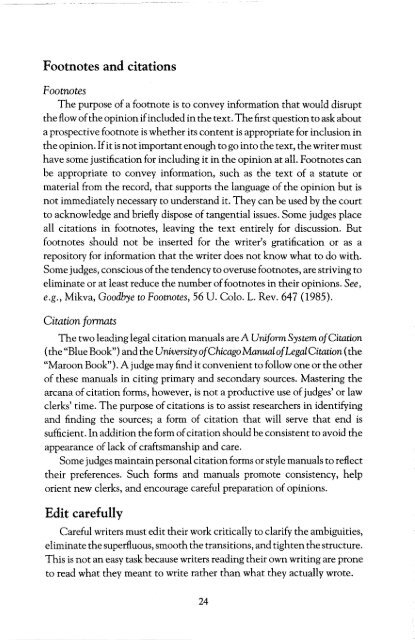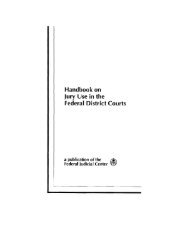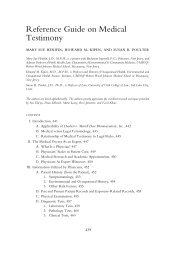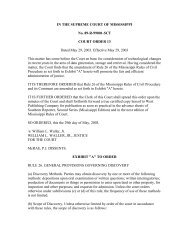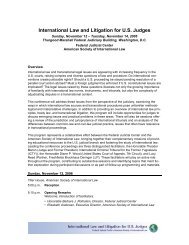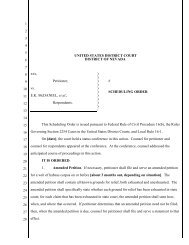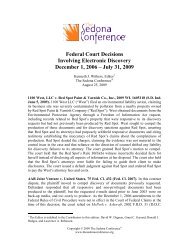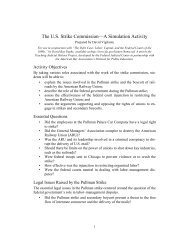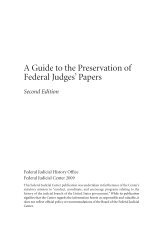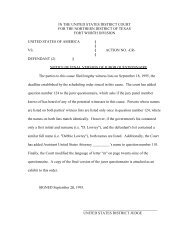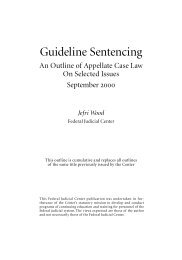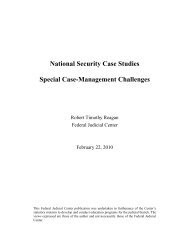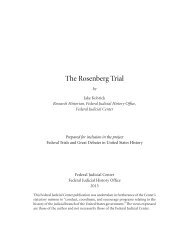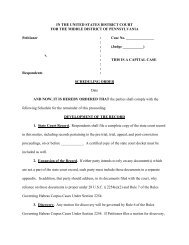Judicial Writing Manual - Federal Judicial Center
Judicial Writing Manual - Federal Judicial Center
Judicial Writing Manual - Federal Judicial Center
You also want an ePaper? Increase the reach of your titles
YUMPU automatically turns print PDFs into web optimized ePapers that Google loves.
Footnotes and citations<br />
Footnotes<br />
The purpose of a footnote is to convey information that would disrupt<br />
the flow of the opinion if included in the text. The first question to ask about<br />
a prospective footnote is whether its content is appropriate for inclusion in<br />
the opinion. If it is not important enough to go into the text, the writer must<br />
have some justification for including it in the opinion at all. Footnotes can<br />
be appropriate to convey information, such as the text of a statute or<br />
material from the record, that supports the language of the opinion but is<br />
not immediately necessary to understand it. They can be used by the court<br />
to acknowledge and briefly dispose of tangential issues. Some judges place<br />
all citations in footnotes, leaving the text entirely for discussion. But<br />
footnotes should not be inserted for the writer's gratification or as a<br />
repository for information that the writer does not know what to do with.<br />
Some judges, conscious of the tendency to overuse footnotes, are striving to<br />
eliminate or at least reduce the number of footnotes in their opinions. See,<br />
e.g., Mikva, Goodbye to Footnotes, 56 U. Colo. L. Rev. 647 (1985).<br />
Citation formats<br />
The two leading legal citation manuals are A Unifonn System of Citation<br />
(the "Blue Book") and the University of Chicago <strong>Manual</strong> of Legal Citation (the<br />
"Maroon Book"). A judge may find it convenient to follow one or the other<br />
of these manuals in citing primary and secondary sources. Mastering the<br />
arcana of citation forms, however, is not a productive use of judges' or law<br />
clerks' time. The purpose of citations is to assist researchers in identifying<br />
and finding the sources; a form of citation that will serve that end is<br />
sufficient. In addition the form of citation should be consistent to avoid the<br />
appearance of lack of craftsmanship and care.<br />
Some judges maintain personal citation forms or style manuals to reflect<br />
their preferences. Such forms and manuals promote consistency, help<br />
orient new clerks, and encourage careful preparation of opinions.<br />
Edit carefully<br />
Careful writers must edit their work critically to clarify the ambiguities,<br />
eliminate the superfluous, smooth the transitions, and tighten the structure.<br />
This is not an easy task because writers reading their own writing are prone<br />
to read what they meant to write rather than what they actually wrote.<br />
24


